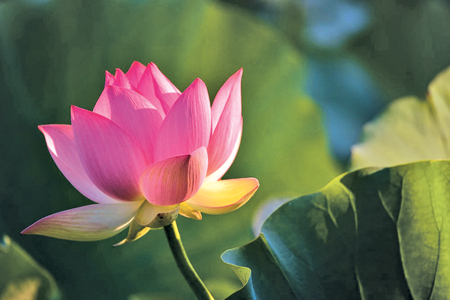
Seeing the Dhamma
 Dr. Most Venerable Dr. Most Venerable
Mirisse Dhammika Nayaka Thera
2568 years have gone by since the Buddha passed away. Today, even though there
is no living Buddha, His Teachings, known as Buddhism are still alive. Thus, is
it possible to see the Buddha by learning and following His Teachings?
During Buddha’s time, a young man named Wakkali became a monk because he was
fascinated by the Buddha’s body. He was preoccupied by thoughts about the
Buddha’s body rather than the teachings. When it was brought to his attention,
the Buddha said (yodhammangpassathi, so mangpassathi) “if one sees the dhamma,
one sees the Buddha”. Therefore, reflecting His supreme qualities and following
the teachings wisely are the noblest ways to respect and adore the Buddha.
Anyone who begins to explore Buddhism may also see this noble being, the Buddha
by learning analytically and following His teachings wisely.
Buddha’s teachings can e followed without any socioeconomic hindrance. The term
human is implied to all mankind. Any division may be based purely on their own
activity rather than by birth. According to Buddhism, a disciplined mind and its
actions shape an individual into a noble human being. This path of action can be
initiated through dana (generosity), sila (morality), bhavana(meditation). It
should not be misunderstood that these activities can be performed only by
Buddhists. Without distinction, any one who strives for physical and mental
peace can achieve these qualities.
 Giving away a certain portion of what one has rightfully earned with purity in
mind and full of happiness is called generosity. One might think, “Why should
one give away any portion of what one has rightfully earned”? When qualities
like mutual respect, trust, compassion, equanimity and patience develop among
humans, the relationship and the value of generosity become more obvious. There
are four things that are common to all beings, namely food, sleep, fear and
reproduction of the species, but human beings are distinct because of the
ability of advanced thinking. Buddhism sees this ability as the basis for
generosity and morality. However, one shall not become generous in anticipation
of returns such as fame, praise, leadership or any other gain. One has to
develop generosity with a pure mind. Giving away a certain portion of what one has rightfully earned with purity in
mind and full of happiness is called generosity. One might think, “Why should
one give away any portion of what one has rightfully earned”? When qualities
like mutual respect, trust, compassion, equanimity and patience develop among
humans, the relationship and the value of generosity become more obvious. There
are four things that are common to all beings, namely food, sleep, fear and
reproduction of the species, but human beings are distinct because of the
ability of advanced thinking. Buddhism sees this ability as the basis for
generosity and morality. However, one shall not become generous in anticipation
of returns such as fame, praise, leadership or any other gain. One has to
develop generosity with a pure mind.
Morality is the discipline of speech and body whereby one’s thoughts, words and
actions are harmless to one-self and to others. Can you imagine how much relief
it brings to all beings? There is no age difference in maintaining morality that
brings personal satisfaction and enhances the development of self confidence.
Sila is two-fold in which engaging in daily activities in a righteous and a
civilized way is described as AbhisamacharikaSila and the non-civilized and
anti-social way of life that cannot maintain morality as AbhibrahmacharikaSila.
Meditation is training of the mind. In the Pali Cannot it reads
“BhavanathiVaddhana”. Mind wonders perpetually and entangles in intentions. The
intentions may be wholesome or unwholesome where wholesome intentions foster
happiness and the unwholesome ones destroy happiness. Therefore, focusing and
keeping the trained and disciplined mind on wholesome thoughts is the first step
in meditation which produces steady physical and mental happiness. By following
in depth meditation, one is able to comprehend the true nature of life with all
its interactions. Then, one realizes that I, me and mind are nothing but
concepts.
While reading this, you may think that this is simple knowledge. The knowledge
is important but its application in daily life is more important. If you lead a
virtuous life already, you may reflect upon the degree of inner peace you have
achieved and enjoyed so far. In AlagaddhupamaSutta, MN, Buddha compared the
dhamma to a raft which is used only to ferry across but not to haul. By mere
learning, expounding, memorizing and listening one cannot gain the real
experience of the dhamma. However, if one practices it even in a small way, one
will honour the Buddha and Dhamma and enjoy peace and harmony. Offering flowers,
incenses, food and various other items to the Buddha, Dhamma and Sangha is an
ancient ritual of the Buddhist cultural life. Only rituals are inadequate to
express real veneration whereas practice is more important to reap the benefits
of the dhamma.
It is incorrect to assume that there is no time to follow the Dhamma in the
current industrious and hectic social environment. One can explore how
individuals living in any society can create a peaceful, satisfying and
compassionate environment through Buddha’s teachings. According to Buddhism
compassion, kindness and patience promote happiness and harmony in life while
remorse, hatred, revenge and greed promote unhappiness and disharmony.
It is worthwhile to depict some examples of Buddhist Saints (Arahants) who
achieved permanent peace and happiness by following the Buddha’s teachings.
These are not super human, but noble qualities that can be developed by average
human beings. Stories such as Kisagothamie, Patachara, Punna and Rajjumala
mentioned in the literature are known to many Buddhists. It is a joy to reflect
on how Buddha helped and relieved those human beings who were engulfed in sorrow
and helplessness. It should not be difficult to imagine the state of mind of a
woman who lost her husband, two children and her parents at the same time.
Patachara was one such woman. While people threw stones at her assuming that she
was an outcast, Buddha helped her to find relief by calling her. “sister”. Those
compassionate words brought relief to her at a time when she was engulfed in
unending sorrow. We often experience the scenarios where individuals are made to
suffer rather than helping them to find relief, happiness and peace. There are
numerous individuals with physical and mental agony caused by social problems.
Even though every one of them cannot be helped economically, helping them with
at least a kind word is a way of seeing the Buddha.
Once the BahminAkkosabharadvaja invited the Buddha to his home. When Buddha
arrived, the Brahim treated him with very harsh words. Imagine, how you would
react if you were confronted with a similar situation. Buddha listened to the
Brahmin and said, “Brahmin!, how would you treat your relatives and friends when
you invite them? Suppose if they refused to take what you offer, doesn’t that
remain with you? Similarly, I do not accept your treatment and it is all yours”.
The Brahmin who was full of remorse and hatred was wise enough to understand the
message. He took refuge in the Buddha.
May you be well, happy and peaceful, finally attain supreme Nibbana |
